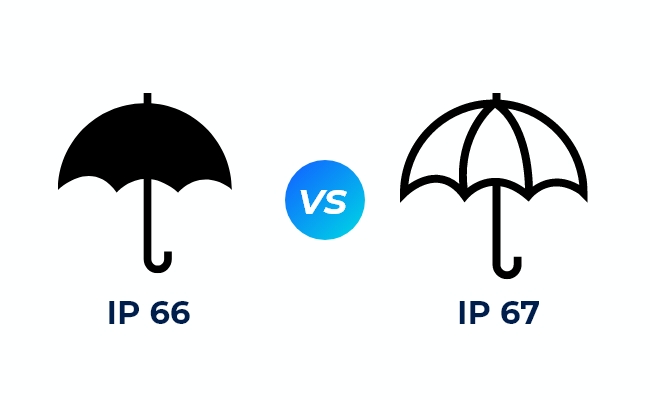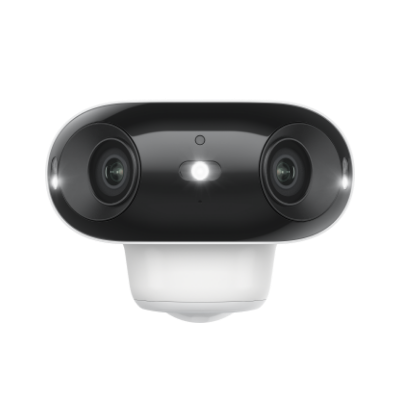IP66 vs IP67: What's the Difference?

Whenever we purchase electronic devices like smartphones, outdoor lights, security cameras, smartwatches, and other gadgets, they often come labeled with terms like IP66 and IP67. These labels tell us about the dust and waterproofing of the product. However, there is a lot more to it. So, in this article, we will compare IP66 vs IP67 so that you know which one you need.
IP Rating Explanation
IP stands for Ingress Protection and it is a system of rating to show the levels of sealing against foreign bodies. This standard of rating is used for electrical enclosures to tell us how safe that enclosure is from external elements like moisture, dust, etc.
Every IP rating has 2 digits in it. The first digit is used to tell the level of protection from solid moving objects like dirt and dust. The second digit tells how protected the enclosure is against liquids and moisture. The moisture can come in different forms, such as sprays, drips, submersion, etc.
In both digits, 0 is the lowest number which means there is no protection at all, and the protection increases as the number increases. Below is a table that shows complete details about different IP ratings.
IP66 vs IP67: What is IP66?
Taking a look at the table above, the IP66 rating gives complete protection against dust, and it offers protection from powerful water jets. This rating signifies that the enclosure is protected against harsh environments. Products that come with this rating are safe from heavy rains, powerful water jets, and ocean waves. One such product is the Reolink Argus 4 Pro. It has a IP66 rating, robust enough to different weather conditions. Most importantly, it offers full color night vision without using visible spotlights, thanks to the ColorX technology.
4k 180° Wire-free Color Night Vision Camera
4K UHD 180° Blindspot-free View; Color Vision Day and Night; 30% More Battery Life; Dual-band Wi-Fi 6; Smart detection.
If you don't want a ColorX camera and prefer traditional spotlights and IR lights, you can choose the Reolink Argus 4.
4k 180° Blindspot-free Wi-Fi 6 Camera
4K UHD 180° Blindspot-free View; Dual-band Wi-Fi 6; Smart detection; Easy Installation Anywhere
IP66 vs IP67: What is IP67
The IP67 rating takes protection from water one step further. While it offers the same maximum level of protection from dust and similar particles, it offers better protection from water. The 7 in this IP rating signifies that the enclosure will be protected from water even when it is immersed in water for 30 minutes and up to 1 meter deep.
Products that come with this rating are good enough to be submerged in water for a short time. For example, smartphones, smartwatches, and other gadgets that come with this rating can be used while showering.
IP66 vs IP67: What’s the Difference?
When you look for the IP66 vs IP67 difference, the major difference that you will note will be about the protection against water. While IP66 offers protection against powerful jets and heavy rain, IP67 has more protection. IP67 protects enclosures from water even when submerged underwater up to 1 meter deep for up to 30 minutes.
This difference can be significant for using a device with an IP rating under the right circumstances. For example, IP66 might be good enough for outdoor harsh conditions while IP67 will be good enough for devices that occasionally go underwater.
IP66 vs IP67: Which One to Choose?
IP66-rated products are free from dust ingress and direct exposure to water jets. So, they are suitable for outdoor environments under severe rain or dust, but not for immersion. The IP67 devices offer the same dust protection as IP66 devices but can further withstand submersion in water up to 1 meter for 30 minutes.
So, IP67 is highly recommended for devices that might be dropped into shallow water or face temporary flooding. Selecting between IP66 and IP67 requires an evaluation of the specific environment a device will face.
IP66 can withstand environments without any submerging risk but there is a possibility of water spraying or dust. IP67 is the better option for devices that are used in the environment with the risk of temporary submersion and flooding.
FAQs
1. Is IP66 better than IP67?
IP66 is not better than IP67 overall protection as it only protects against high-pressure water. IP67 provides greater water resistance with the possibility to be submerged in water up to 1 meter for 30 minutes. That is why it is an ideal option in environments where devices are submerged in water.
2. Is IP66 fully waterproof?
IP66 is not a fully waterproof IP rating. The housing is constructed to resist highly pressurized water jets and is 100% dust-tight, making it acceptable in certain outdoor environments. However, it cannot stand continuous submersion in water.
3. Is IP67 really waterproof?
IP67 is rated as water-resistant for most purposes, such as water immersion to a depth of 1 meter for 30 min. This level of protection helps the device robust enough to serve in a location with short-term immersion. However, it is not completely waterproof if you go deeper underwater or stay up to 1-meter depth for over 30 minutes.
4. Which is better IP65 or IP67?
IP67 is the better choice of the two as it offers much more protection than IP65. IP67 devices are submersible in water temporarily and are also a few inches of dustproof, thus suitable for more complicated settings. IP65 rating is essentially suitable for low-power water jets and slight rain. IP66, situated between these two, protects against high-pressure water jets but not against immersion.
Conclusion
When buying an electronic device like an outdoor security camera, you will come across ratings like IP66 and IP67. Not knowing what these ratings stand for confuses many people. So, in this IP66 vs IP67 comparison we explained these terms and their differences. We elaborated on how IP67 offers more protection in environments where your devices might be submerged while IP66 is good enough even in heavy rain. So, now you can make your purchase decision efficiently.
Search
Subscribe for the Latest Updates
Security insights & offers right into your inbox





























































































































































